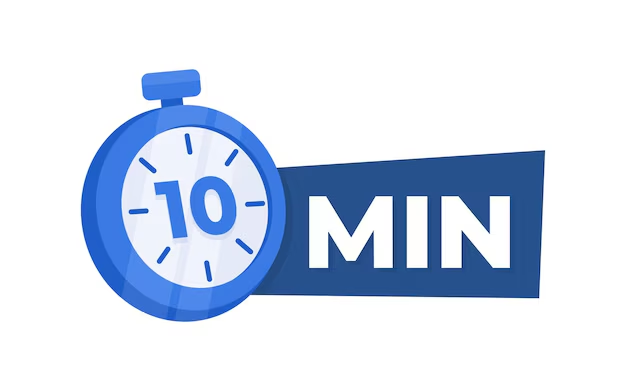Maximize Your Productivity with a 10 Minute Timer

Introduction to the 10 Minute Timer
The concept of 10 minute timer using a timer for productivity is rooted in the Pomodoro Technique, developed by Francesco Cirillo in the late 1980s. This method promotes working in intervals, traditionally set at 25 minutes, followed by a short break. However, the 10 minute timer has emerged as a practical alternative, enabling individuals to harness focused bursts of productivity while maintaining clarity and energy levels. The shorter time frame appeals to those who may feel overwhelmed by longer task durations, making it a more accessible approach for various tasks.
Utilizing a 10 minute timer allows individuals to dissect larger projects into smaller, more manageable segments. This technique not only reduces procrastination but also enhances concentration, as the limited time encourages a focused mindset. The psychological benefits of this method are significant; individuals often find themselves increasingly motivated to complete tasks because the end is always within reach. Few methods provide such concrete evidence of time management success, creating a sense of accomplishment with each mini-session.
Additionally, modern technology has facilitated the rise in popularity of timed productivity techniques. Numerous applications and devices are now available that allow users to easily set a 10 minute timer, providing flexibility in a fast-paced world. Users can choose when to implement this strategy throughout their days, whether working from home, studying, or engaging in everyday chores. The advantages are manifold—by employing a timer, individuals can experience heightened accountability for their time and improved performance in both personal and professional spheres.
Incorporating a 10 minute timer into one’s routine not only promotes effective time management but also emphasizes the importance of periodic breaks, ultimately leading to a more sustainable work-life balance. By examining its applications and benefits, it becomes clear why the 10 minute timer has solidified its place as a favored productivity tool among many.
The Science Behind Time Management
Time management is a crucial aspect of productivity, and research shows that structured time intervals can significantly enhance concentration and efficiency. One popular method is the Pomodoro Technique, which involves working in short, focused intervals—typically 25 minutes—followed by brief breaks. However, the application of shorter time frames, such as a 10 minute timer, can also be notably effective. This approach aligns with cognitive theories that suggest our attention span can be maximized through succinct, concentrated efforts.
Studies in behavioral psychology reveal that breaking tasks into smaller segments can lead to improved focus. When using a 10 minute timer, individuals can commit to a task without the overwhelming feeling of a looming deadline. This method capitalizes on the finite nature of the time allotted, making it easier to muster motivation and maintain engagement. Such bursts of effort create a sense of urgency, which can drive productivity levels higher than traditional work periods.
Additionally, time management strategies that incorporate short intervals have been shown to reduce mental fatigue. After a focused session concludes, even if it is just 10 minutes, individuals are often more inclined to take productive breaks, which allows for mental rejuvenation. This cyclical pattern of working and resting can lead to enhanced overall efficiency, keeping individuals motivated over extended periods.
The compatibility of a 10 minute timer with various tasks—whether it be deep work, studying, or even household chores—makes it a versatile tool in any productivity arsenal. By integrating this time management strategy, individuals may find a balance between intense focus and necessary rest, ultimately fostering better results in their personal and professional lives.
Choosing the Best Timer for You
In today’s fast-paced world, selecting the right timer can significantly impact your productivity. There are various types of timers available, each serving a unique purpose and offering different features. Understanding these options is crucial to find a 10 minute timer that best meets your personal preferences and work requirements.
Physical timers are one of the most traditional options. These devices are standalone and often feature simple dials or buttons for setting time intervals. A mechanical timer adds a tangible aspect to time management, often allowing for quick adjustments. Many people appreciate the straightforward mechanics of physical timers, as they do not rely on battery life or screen time. For those who prefer minimal distractions, a tactile timer can be an excellent choice.
For those more integrated with technology, smartphone applications provide versatility and convenience. Numerous apps are designed for the specific purpose of timing activities, allowing users to set a 10 minute timer with a simple tap. These applications often feature additional tools such as task lists, reminders, and even features for tracking productivity over time. The customization options available in many apps can cater to a variety of tasks, from studying to exercise, making them suitable for diverse needs.
Online options, including web-based timers, offer another layer of accessibility. These timers can usually be accessed from any browser, which is particularly useful for individuals who work on multiple devices. Simple and user-friendly interfaces allow users to quickly start a 10 minute timer while maintaining focus on their tasks. Additionally, many online timers come with features such as visual alerts and sound notifications, further enhancing productivity.
Ultimately, the best timer for you will depend on your specific needs and work style. By considering factors like ease of use, accessibility, and personal preferences, you can find the ideal timer to help boost your productivity effectively.
Effective Strategies for Using a 10 Minute Timer
Incorporating a 10 minute timer into your daily routine can significantly enhance focus and productivity. One of the most effective strategies is to set achievable and specific goals for each session. Instead of attempting to tackle a huge project in one go, break it down into manageable tasks. For instance, if you are working on a report, use the timer to focus on drafting one section or gathering necessary research. This tactic allows you to create a sense of accomplishment after each interval, paving the way for sustained motivation.
Another strategy involves prioritizing tasks effectively. Begin by listing all tasks that need to be completed and then rank them based on urgency and importance. Once prioritized, allocate your 10 minute timer to the most pressing task first. This method ensures that you address critical objectives without feeling overwhelmed, as you can concentrate fully on one task at a time without multi-tasking, which can dilute your efforts and lead to decreased productivity.
Additionally, it is beneficial to incorporate progress reviews into your routine. After a focused 10 minute session, take a few moments to reflect on what you have accomplished and what needs further attention. This reflection helps to consolidate knowledge from the completed tasks and can prevent stagnation in your workflow. You can adjust your goals for the next session based on what you learned during your review. This cyclic approach not only enhances your productivity but also fosters continuous improvement.
By effectively integrating these strategies into your routine, a 10 minute timer can become an invaluable tool for maximizing productivity. Start small, track your progress, and gradually increase the complexity of your objectives as you become more adept at using this time management technique.
Common Challenges and How to Overcome Them
Implementing a 10 minute timer for your productivity can present various challenges, particularly for those unaccustomed to structured time management. One significant hurdle individuals often encounter is the prevalence of distractions. External interruptions, whether from notifications on smartphones, conversations in the vicinity, or even ambient noise, can disrupt focus and diminish the effectiveness of a timed session. To counteract this, it is advisable to create a conducive work environment. Consider silencing your phone, utilizing noise-cancelling headphones, or even employing apps that block social media during your timer sessions.
Another common challenge is the difficulty in maintaining focus for the full ten minutes. As the mind tends to wander, it becomes difficult to sustain concentration on the task at hand. To address this, employing techniques such as the Pomodoro method, which involves short bursts of work followed by brief breaks, may be beneficial. For example, you could set a 10 minute timer for focused work, followed by a 2-minute break to reset your mind. This approach not only enhances focus but also helps in easing the transition into longer work sessions.
Additionally, some may find themselves grappling with anxiety about completing tasks within the ten-minute constraint, leading to procrastination rather than productivity. Overcoming this challenge requires a mindset shift—view the timer not as a constraint but as an ally. Instead, focus on the concept of making progress in small increments. Familiarity with this method can gradually build confidence and reduce the pressure associated with performing under a strict time frame. Ultimately, with perseverance and strategic adjustments, individuals can successfully navigate these challenges and harness the productivity benefits of a 10 minute timer.
Integrating the 10 Minute Timer into Work and Life
In an era where distractions abound and attention spans are waning, the utility of a 10 minute timer becomes increasingly relevant. This tool can be effectively integrated into various facets of daily life, enhancing focus and productivity. Especially in work environments, implementing a short timer helps in breaking tasks into manageable segments. For instance, when faced with a looming deadline, using a timer can prompt employees to concentrate their efforts on a specific task for just ten minutes, encouraging immediate progress and reducing feelings of overwhelm.
Beyond the workplace, the 10 minute timer serves a significant role in academic settings. Students can utilize short intervals of focused study, interspersed with brief breaks. Techniques like the Pomodoro method suggest studying for a concise duration, followed by a pause, allowing for enhanced retention and understanding. A 10 minute timer can facilitate this approach, as students can concentrate on a topic without the daunting prospect of long study sessions draining their motivation.
Physical fitness routines can also benefit immensely from this time management strategy. Whether engaging in a high-intensity workout or a simple home exercise, setting a 10 minute timer can create an effective regimen that promotes engagement and stamina. It transforms exercise into a structured event, making it easier to commit to regular physical activity.
Finally, the utility of the 10 minute timer extends to household chores, effectively managing one’s time during mundane tasks. By allocating specific chores to 10 minute intervals, individuals can foster a sense of accomplishment and maintain a tidy living space without the burden of endless chores. In leveraging the timer, one cultivates focus, making it easier to integrate productivity-enhancing techniques across various areas of life.
Real-Life Success Stories
Many individuals have successfully integrated a 10 minute timer into their routines, leading to remarkable improvements in their productivity. One such example is Sarah, a freelance graphic designer. Faced with constant distractions while working from home, Sarah discovered the Pomodoro Technique, which emphasizes short, focused bursts of work followed by brief breaks. By setting a 10 minute timer, she was able to concentrate intensely on a single task. This approach not only helped her minimize procrastination but also increased her output significantly. Within weeks, Sarah noted a dramatic transformation in her workflow, allowing her to take on more clients without an increase in stress levels.
Another notable case is that of Thomas, a project manager in a large corporation. Struggling with lengthy meetings and overwhelming emails, he started using a 10 minute timer to tackle specific parts of his workday. Whenever he had a task he dreaded, Thomas would set a timer for 10 minutes and commit to working on it without interruption. This practice made daunting tasks more manageable, leading to increased task completion rates and giving him a sense of accomplishment. His colleagues soon adopted similar strategies, leading to improved overall efficiency within the team.
Additionally, many students have begun employing a 10 minute timer for their study sessions. Emily, a college student, found that by breaking her study materials into 10-minute segments, she could maintain high levels of focus while absorbing crucial information. This not only promoted better retention of material but also alleviated the anxiety commonly associated with exams and deadlines. Through the implementation of this simple yet powerful tool, Emily was able to achieve higher grades while maintaining a balanced lifestyle.
These testimonials highlight the versatile applications of a 10 minute timer in various settings. By embracing this method, people can enhance their productivity and find a more structured approach to their daily tasks.
Tips for Staying Consistent with Your Timer Routine
Establishing a consistent routine with a 10 minute timer can significantly enhance productivity and efficiency. However, maintaining this consistency may require effort and strategic planning. One effective method for creating consistency is to set reminders. Utilize digital calendars or task management apps to schedule specific times for your timer sessions. Setting alarms for intervals throughout the day can serve as gentle nudges, prompting you to pause tasks and engage with your timer. This structured approach helps reinforce the habit of using a timer and makes it easier to integrate into your daily routine.
Forming a habit around the 10 minute timer also involves repetition and discipline. Begin by committing to using the timer at the same time every day. This could be a set time in the morning, during lunch breaks, or even in the evening when winding down for the day. Gradually, as you incorporate the timer into your schedule, it will become a natural part of your workflow. Consistency in the timing can lead to increased familiarity with the technique, eventually making it easier to engage with the timer without any conscious effort.
Another powerful strategy is to integrate the use of the timer into existing tasks. For instance, you might decide to use the 10 minute timer before or after meetings, during brainstorming sessions, or when tackling lengthy tasks. This can not only help enhance focus during work but also act as a boundary, ensuring that you take necessary breaks to prevent burnout. By strategically placing your timer in various points of your daily workflow, you cultivate an environment that fosters productivity and encourages sustained engagement with your tasks. Ultimately, the key lies in consistency and integration, ensuring that the 10 minute timer becomes an indispensable tool in your productivity arsenal.
Conclusion: Start Your 10 Minute Timer Journey Today
Incorporating a 10 minute timer into your daily routine can significantly enhance your productivity and focus. This simple yet effective tool breaks tasks into manageable intervals, making larger projects feel less daunting and ensuring that you maintain a sense of urgency throughout your work. By dedicating just ten minutes at a time, you can create a structure that amplifies your concentration and keeps distractions at bay.
Using a 10 minute timer promotes the practice of time management and encourages consistency in your workflow. This technique allows for periods of intense focus followed by brief breaks, optimizing both mental stamina and creativity. Additionally, the short bursts encouraged by the timer often lead to improved retention of information and increased efficiency, making it easier to achieve your goals and deadlines.
As you embark on this journey, consider starting small. Choose a single task that you have been procrastinating on and set your 10 minute timer. Observe how you feel during and after this focused work session. Once you become accustomed to this technique, gradually implement it into various aspects of your life, whether at work or in personal projects. The key is to experiment with your workflow and adapt the timing to suit your needs.
We encourage you to share your experiences with the 10 minute timer. Did you notice increased productivity? What strategies did you find most effective? Your feedback can inspire others to adopt this powerful method. Begin today, harness the potential of focused work, and unlock new levels of productivity in your daily life. With consistent practice, you may find that these short intervals become a cornerstone of your efficiency and creativity, making your workday more productive than ever before.
You May Also Read This Usaworldtoday.




